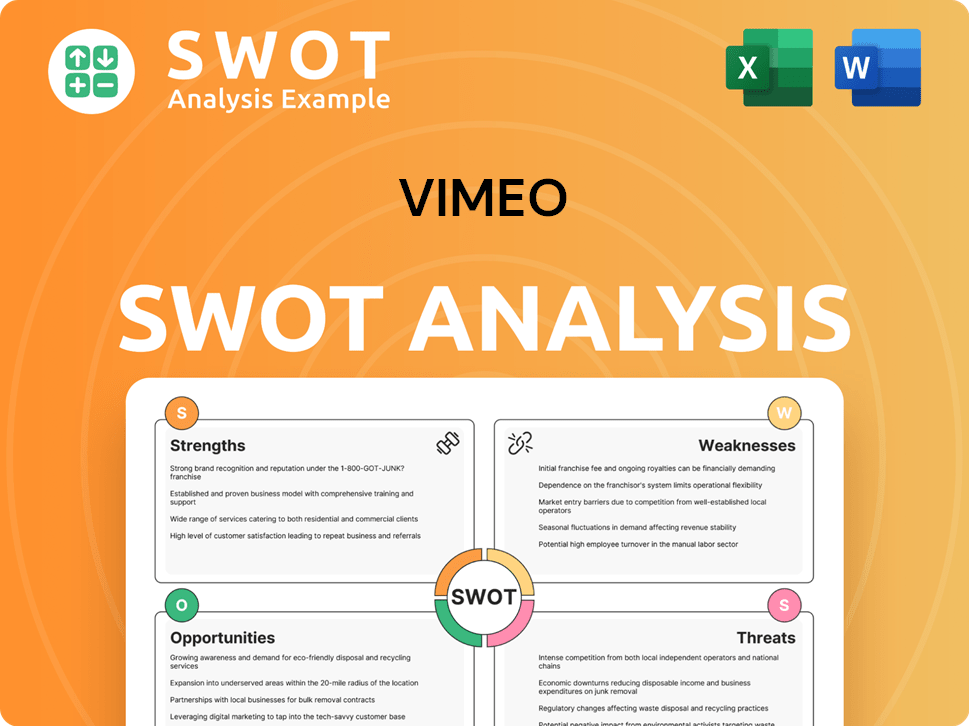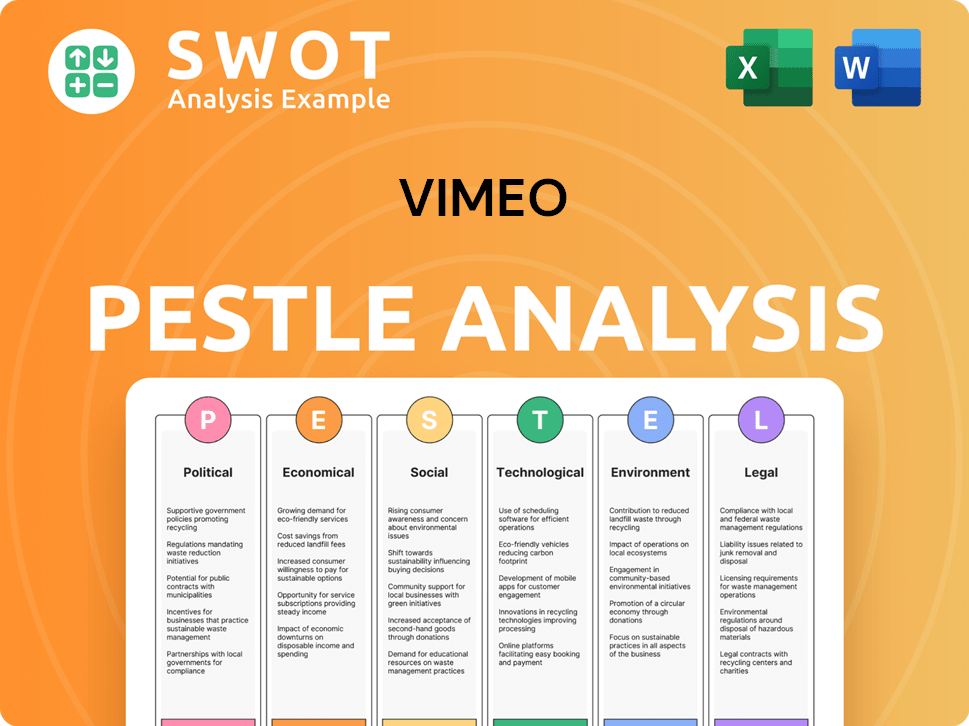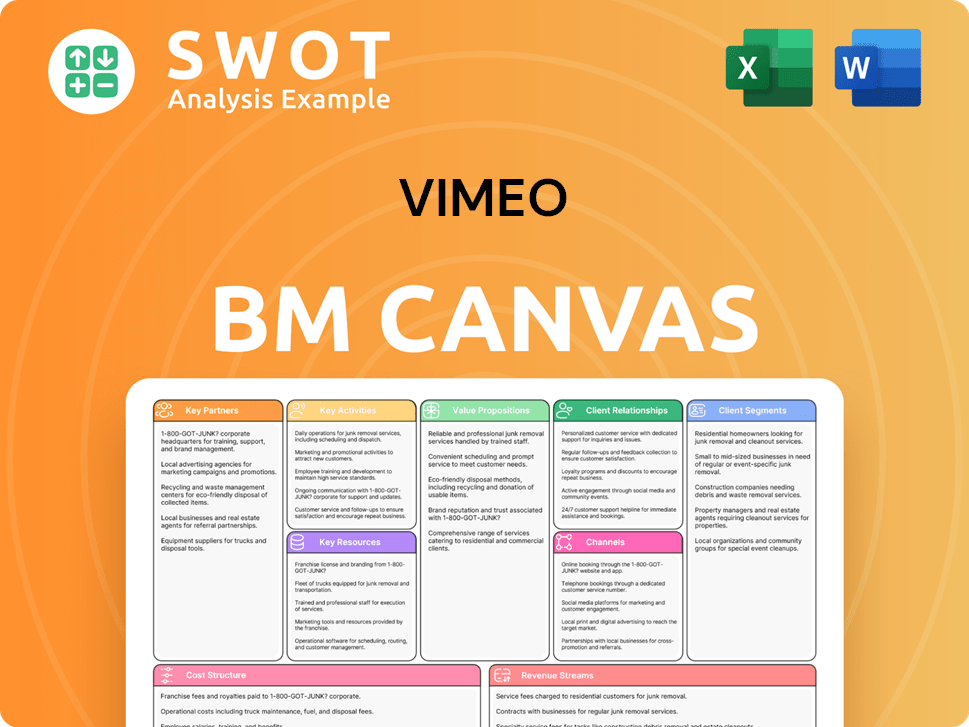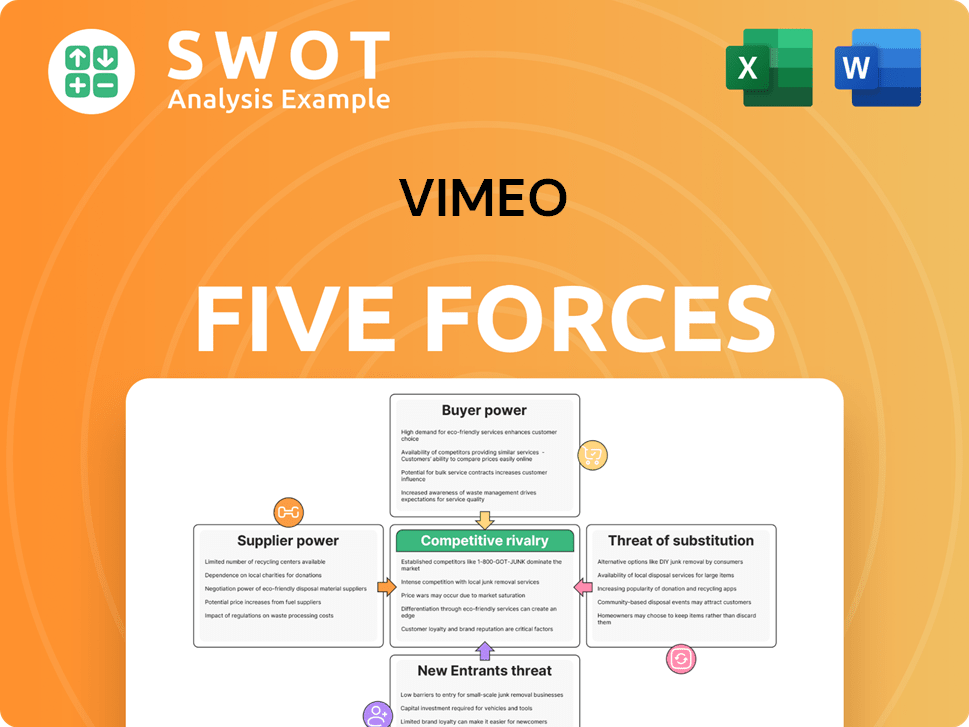Vimeo Bundle
How Does Vimeo Stack Up in the Video-Sharing Wars?
In the ever-evolving world of online video, understanding the Vimeo SWOT Analysis is crucial for anyone looking to leverage video for business or creative endeavors. This platform has carved a unique space, but how does it fare against the giants and emerging players in the video hosting landscape? This in-depth analysis delves into the Vimeo competitive landscape, exploring its strengths, weaknesses, and strategic positioning within the market.

From its origins as a simple video-sharing site to its current status as a publicly traded company, Vimeo has consistently adapted to the demands of the market. Examining its Vimeo competitors and conducting a thorough Vimeo market analysis reveals the key factors driving its success. This exploration of video hosting platforms and online video platforms will provide insights into Vimeo's Vimeo's market share 2024 and its future trajectory.
Where Does Vimeo’ Stand in the Current Market?
Vimeo carves out a distinct market position within the video software and services sector, focusing on businesses and creative professionals. This strategic focus differentiates it from broader consumer-oriented platforms. As a leader in professional video hosting and management, Vimeo's primary offerings include video hosting, live streaming, video creation tools, and marketing solutions.
The platform's global presence, with significant customer bases across North America, Europe, and Asia, supports a diverse range of users, from SMBs to large enterprises, as well as individual creators and educators. Vimeo's shift from a general video-sharing platform to a specialized, premium offering is a key aspect of its strategy. This move allows it to attract clients willing to pay for advanced features, reliability, and an ad-free experience, setting it apart from free, ad-supported alternatives.
Financially, Vimeo reported a revenue of $105.7 million in the first quarter of 2024. Its subscription-based model provides a more stable revenue stream compared to ad-supported models. Vimeo's focus on providing a comprehensive suite of video tools for professional use cases, including marketing, internal communications, and e-learning, underscores its strong position in these specialized segments. For a deeper understanding of its origins, you can explore the Brief History of Vimeo.
Vimeo's primary focus is on business-to-business (B2B) solutions and creative professionals. This strategic direction allows it to provide specialized tools and services tailored to professional video production and distribution needs. This approach contrasts with platforms that cater to a broader consumer base.
Vimeo operates on a subscription-based model, offering various pricing plans to suit different user needs. This model provides a predictable revenue stream, which is a key advantage in the competitive landscape of online video platforms. The subscription model also supports the development of advanced features and customer support.
Vimeo has a global footprint, with a significant presence in North America, Europe, and Asia. This broad geographic reach allows it to serve a diverse customer base and tap into various markets. Its international presence is supported by localized services and support.
Vimeo serves a wide range of customers, including SMBs, large enterprises, individual creators, and educators. This diverse customer base allows it to provide a broad range of services and solutions. The platform adapts its offerings to meet the specific needs of each customer segment.
Vimeo's competitive advantage lies in its focus on professional video solutions, its subscription-based revenue model, and its commitment to providing an ad-free experience. These factors help it stand out in the crowded market of video hosting platforms.
- Professional-grade tools for video creation, editing, and distribution.
- Reliable and secure video hosting with advanced features.
- Ad-free viewing experience, enhancing user satisfaction.
- Targeted towards businesses and creative professionals.
Vimeo SWOT Analysis
- Complete SWOT Breakdown
- Fully Customizable
- Editable in Excel & Word
- Professional Formatting
- Investor-Ready Format

Who Are the Main Competitors Challenging Vimeo?
The Growth Strategy of Vimeo is significantly influenced by its competitive environment. The Vimeo competitive landscape is multifaceted, encompassing direct and indirect rivals that vie for market share in the video hosting and online video platforms sectors. Understanding these competitors is crucial for analyzing Vimeo's market analysis and strategic positioning.
Vimeo competitors range from specialized video solution providers to large technology conglomerates. These competitors challenge Vimeo across various aspects, including features, pricing, and target audience. The dynamic nature of the video technology market requires continuous evaluation of the competitive landscape to adapt and maintain a competitive edge.
Direct competitors in the professional video hosting and management space include platforms like Wistia, Brightcove, and Vidyard. These platforms offer similar services, each with its own strengths and specializations.
Wistia focuses on video marketing for businesses, providing analytics and integrations. It competes directly with Vimeo’s marketing-focused solutions. Recent data indicates that Wistia's user base is primarily composed of small to medium-sized businesses (SMBs) looking for robust video marketing tools.
Brightcove caters to larger enterprises with live streaming and video-on-demand services. It often competes for high-value corporate clients. According to recent reports, Brightcove's revenue in 2024 is projected to be around $250 million, reflecting its strong position in the enterprise market.
Vidyard specializes in video for sales and marketing, offering personalized video tools. It directly overlaps with Vimeo's business-focused offerings. Vidyard has been expanding its features to include more advanced analytics and integrations, targeting a similar customer base as Vimeo.
YouTube, a general-purpose video platform, indirectly competes with Vimeo. It has a massive user base and offers business features. YouTube's ad revenue in 2024 is expected to exceed $30 billion, demonstrating its dominance in the online video market.
Social media giants like Facebook and Instagram also indirectly compete with Vimeo. They are increasingly integrating business features and live streaming capabilities. Facebook's video views continue to rise, posing a challenge to platforms like Vimeo.
Cloud service providers like AWS and Google Cloud offer video infrastructure services. Larger enterprises can use these to build custom solutions, bypassing platforms like Vimeo. The cloud infrastructure market is growing rapidly, with AWS and Google Cloud holding significant market shares.
Indirect competition also comes from general-purpose video sharing sites like YouTube and social media platforms such as Facebook and Instagram. These platforms attract potential users, especially SMBs, with cost-effective solutions. Furthermore, cloud service providers like Amazon Web Services (AWS) and Google Cloud offer video infrastructure services, enabling larger enterprises to build custom video solutions. The Vimeo vs YouTube comparison often highlights differences in target audience and features, with YouTube focusing on broader content and Vimeo on professional video creators. The Vimeo's market share 2024 remains competitive, with the company continuously innovating to maintain its position.
The competitive landscape is shaped by emerging players and specialized tools. Companies offering niche solutions for video editing, animation, or interactive video can indirectly compete. Mergers and acquisitions within the tech industry also shift competitive dynamics.
- Market Segmentation: Competitors often target different segments. Wistia focuses on marketing, Brightcove on enterprises, and Vidyard on sales.
- Pricing Strategies: Pricing plans vary widely, influencing the Vimeo pricing plans analysis.
- Feature Sets: Platforms differentiate through features like live streaming, analytics, and content creation tools.
- Technological Advancements: Continuous innovation in video technology impacts the competitive landscape.
Vimeo PESTLE Analysis
- Covers All 6 PESTLE Categories
- No Research Needed – Save Hours of Work
- Built by Experts, Trusted by Consultants
- Instant Download, Ready to Use
- 100% Editable, Fully Customizable

What Gives Vimeo a Competitive Edge Over Its Rivals?
Understanding the competitive landscape of video hosting platforms requires a deep dive into the strengths and weaknesses of key players. This analysis provides a detailed look at the factors driving success in this dynamic market, focusing on how companies like Vimeo compete. A comprehensive Vimeo market analysis reveals its unique position.
Vimeo's competitive advantages are rooted in its focus on professional-grade video solutions, its robust platform capabilities, and its strong brand reputation among creators and businesses. This includes its commitment to high-quality video and an ad-free experience. The platform has cultivated a strong reputation over the years as a platform for high-quality content and serious creators.
This article will explore the key elements that define Vimeo's competitive edge, its strategic moves, and how it navigates the challenges within the video hosting industry. The goal is to provide a comprehensive understanding of Vimeo's market position and its outlook for the future, including its key partnerships and growth strategies.
Vimeo distinguishes itself with an ad-free environment, which is highly valued by businesses and creators. This focus on quality and a seamless viewing experience sets it apart from many free platforms. This commitment enhances brand integrity and user satisfaction, creating a premium feel.
Vimeo's advanced features are supported by proprietary technologies, including its sophisticated video player and robust content delivery network (CDN). These technologies provide reliable live streaming, high-resolution video playback, and detailed analytics. This technological strength enables it to offer superior performance.
The platform offers an extensive suite of tools for video creation, editing, and collaboration. This allows users to manage their entire video workflow within a single ecosystem. This comprehensive approach simplifies the process for users, making it a one-stop solution.
Vimeo has built a strong brand reputation as a platform for high-quality content and serious creators. This perception attracts a discerning user base and fosters a loyal community. This reputation drives organic growth and strengthens its market position.
Vimeo's competitive advantages are multifaceted, including its ad-free environment, proprietary technologies, and strong brand reputation. These factors contribute to its success in the competitive video hosting market. The company leverages these advantages in its marketing by emphasizing its premium features and professional community.
- Ad-Free Environment: Provides a clean, professional viewing experience.
- Proprietary Technologies: Offers reliable live streaming and high-resolution playback.
- Comprehensive Tools: Supports the entire video workflow within one platform.
- Brand Reputation: Attracts a discerning user base and fosters loyalty.
The Vimeo competitive landscape is influenced by several factors, including the rapid pace of technological innovation and the increasing sophistication of video tools offered by competitors. However, Vimeo's continuous investment in product development, its focus on niche markets, and its established brand presence contribute to the sustainability of its competitive edge. For more insights into Vimeo's strategic approach, consider examining the Growth Strategy of Vimeo.
Vimeo Business Model Canvas
- Complete 9-Block Business Model Canvas
- Effortlessly Communicate Your Business Strategy
- Investor-Ready BMC Format
- 100% Editable and Customizable
- Clear and Structured Layout

What Industry Trends Are Reshaping Vimeo’s Competitive Landscape?
The video software and services sector is experiencing dynamic shifts, creating both hurdles and chances for platforms like Vimeo. Understanding the Vimeo competitive landscape involves assessing industry trends, potential risks, and future growth prospects. This analysis is crucial for stakeholders, including investors and business strategists, to make informed decisions in a rapidly evolving market. The Vimeo market analysis must consider technological advancements, regulatory changes, and the competitive pressure within the video hosting platforms space.
The outlook for Vimeo depends heavily on its ability to adapt to industry changes and capitalize on emerging opportunities. The company's success hinges on its capacity to innovate, maintain compliance with evolving regulations, and effectively compete with established players. A detailed examination of Vimeo's strengths, weaknesses, and strategic positioning is essential to evaluate its long-term viability and growth potential.
Technological advancements, especially in AI and machine learning, are revolutionizing video creation and editing. Live streaming and interactive video are also growing, driven by demand for real-time communication. These trends offer opportunities for platforms to expand their offerings and enhance user engagement. The Vimeo vs YouTube comparison highlights the need for continuous innovation and differentiation.
Regulatory changes concerning data privacy and content moderation pose significant challenges. Market saturation and aggressive pricing strategies from competitors also add pressure. Maintaining compliance and differentiating services are crucial for survival. Understanding Vimeo competitors is key to navigating these challenges effectively.
Emerging markets and specialized vertical industries present significant growth opportunities. Strategic partnerships and tailored solutions can unlock new revenue streams. Expanding into regions with growing digital economies is essential. The Vimeo's growth strategy should focus on these areas.
Adaptability, proactive problem-solving, and the ability to capitalize on new opportunities are crucial for long-term success. Continuous innovation, compliance with regulations, and effective competition are key. The Vimeo's business model must evolve to meet these challenges. Consider the Target Market of Vimeo to better understand its position.
Vimeo must integrate AI-powered tools to streamline workflows and enhance features. Expanding live streaming and interactive video capabilities is vital. Compliance with data privacy regulations, such as GDPR and CCPA, is essential. The Vimeo's features and functionality should be continuously updated.
- Focus on AI integration for automated video generation and smart editing.
- Expand live streaming services and interactive video features to meet evolving demands.
- Ensure compliance with data privacy regulations and robust content moderation policies.
- Explore emerging markets and specialized industries for new revenue streams.
Vimeo Porter's Five Forces Analysis
- Covers All 5 Competitive Forces in Detail
- Structured for Consultants, Students, and Founders
- 100% Editable in Microsoft Word & Excel
- Instant Digital Download – Use Immediately
- Compatible with Mac & PC – Fully Unlocked

Related Blogs
- What are Mission Vision & Core Values of Vimeo Company?
- What is Growth Strategy and Future Prospects of Vimeo Company?
- How Does Vimeo Company Work?
- What is Sales and Marketing Strategy of Vimeo Company?
- What is Brief History of Vimeo Company?
- Who Owns Vimeo Company?
- What is Customer Demographics and Target Market of Vimeo Company?
Disclaimer
All information, articles, and product details provided on this website are for general informational and educational purposes only. We do not claim any ownership over, nor do we intend to infringe upon, any trademarks, copyrights, logos, brand names, or other intellectual property mentioned or depicted on this site. Such intellectual property remains the property of its respective owners, and any references here are made solely for identification or informational purposes, without implying any affiliation, endorsement, or partnership.
We make no representations or warranties, express or implied, regarding the accuracy, completeness, or suitability of any content or products presented. Nothing on this website should be construed as legal, tax, investment, financial, medical, or other professional advice. In addition, no part of this site—including articles or product references—constitutes a solicitation, recommendation, endorsement, advertisement, or offer to buy or sell any securities, franchises, or other financial instruments, particularly in jurisdictions where such activity would be unlawful.
All content is of a general nature and may not address the specific circumstances of any individual or entity. It is not a substitute for professional advice or services. Any actions you take based on the information provided here are strictly at your own risk. You accept full responsibility for any decisions or outcomes arising from your use of this website and agree to release us from any liability in connection with your use of, or reliance upon, the content or products found herein.